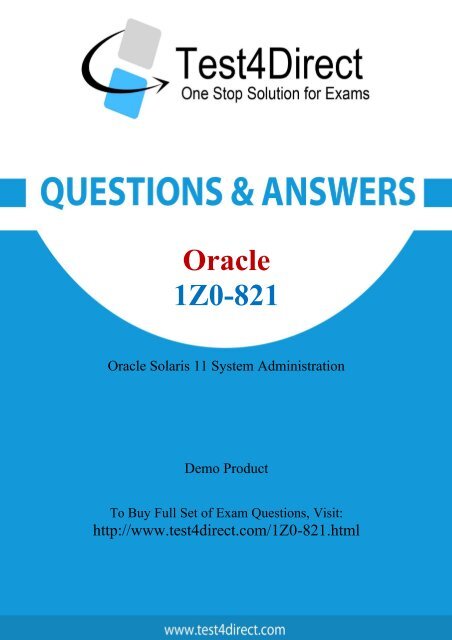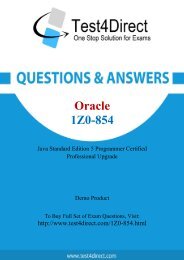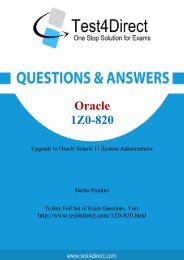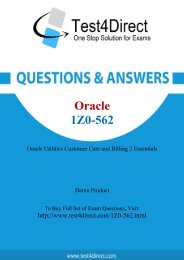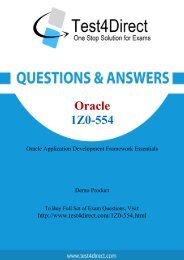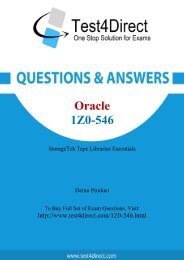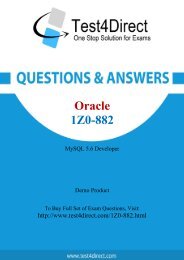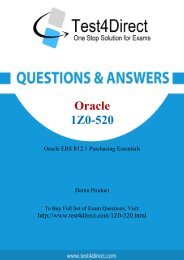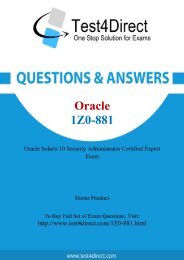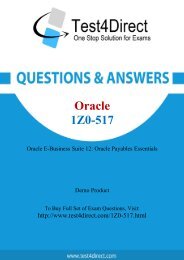Up-to-Date 1Z0-821 Exam BrainDumps
Test4Direct provides latest PDF questions of Oracle 1Z0-821 exam. You have an opportunity to pass the Oracle 1Z0-821 exam in one go. Test4Direct is most accurate source to prepare Oracle 1Z0-821 exam as your success will become site’s responsibility after purchasing 1Z0-821 exam product. There are also lots of discounts and promotion offers that you can avail. Let’s try a free demo http://www.test4direct.com/1Z0-821.html
Test4Direct provides latest PDF questions of Oracle 1Z0-821 exam. You have an opportunity to pass the Oracle 1Z0-821 exam in one go. Test4Direct is most accurate source to prepare Oracle 1Z0-821 exam as your success will become site’s responsibility after purchasing 1Z0-821 exam product. There are also lots of discounts and promotion offers that you can avail. Let’s try a free demo http://www.test4direct.com/1Z0-821.html
Create successful ePaper yourself
Turn your PDF publications into a flip-book with our unique Google optimized e-Paper software.
Oracle<br />
<strong>1Z0</strong>-<strong>821</strong><br />
Oracle Solaris 11 System Administration<br />
Demo Product<br />
To Buy Full Set of <strong>Exam</strong> Questions, Visit:<br />
http://www.test4direct.com/<strong>1Z0</strong>-<strong>821</strong>.html
Question: 1<br />
zone1 is a non-global zone that has been configured and installed. zone1 was taken down for<br />
maintenance, and the following command was run: zoneadm -z zone1 mark incomplete The<br />
following information is displayed when listing the zones on your system:<br />
Which task needs <strong>to</strong> be performed before you can boot zone1?<br />
A. The zone needs <strong>to</strong> be installed.<br />
B. The zone needs <strong>to</strong> be brought <strong>to</strong> the ready state.<br />
C. The zone needs <strong>to</strong> be uninstalled and reinstalled.<br />
D. The zone needs <strong>to</strong> be brought <strong>to</strong> the complete state.<br />
Question: 2<br />
Answer: C<br />
Explanation:<br />
If administrative changes on the system have rendered a zone unusable or inconsistent, it is possible<br />
<strong>to</strong> change the state of an installed zone <strong>to</strong> incomplete. Marking a zone incomplete is irreversible. The<br />
only action that can be taken on a zone marked incomplete is <strong>to</strong> uninstall the zone and return it <strong>to</strong><br />
the configured state.<br />
Reference: Installing, Booting, Halting, Uninstalling, and Cloning Non-Global Zones (Tasks), How <strong>to</strong><br />
Mark an Installed Non-Global Zone Incomplete<br />
You need <strong>to</strong> make sure that all of the software packages on your server are up <strong>to</strong> date. Without<br />
installing any updates, which two commands would display .my software updates that are available<br />
in the default Oracle reposi<strong>to</strong>ry?<br />
A. pkg list -u<br />
B. pkg verify –u ‘*’<br />
C. pkg search –u<br />
D. pkg info –r ‘*’<br />
E. pkg install –nv<br />
F. pkg update –nv ‘*’<br />
Answer: A,D<br />
Explanation:<br />
A: the pgk list command display a list of packages in the current image, including state and other<br />
information. By default, package variants for a different architecture or zone type are excluded.<br />
D: pkginfo displays information about software packages that are installed on the system (with the<br />
first synopsis, with -l) or that reside on a particular device or direc<strong>to</strong>ry (with the second synopsis,
with -r).<br />
Without options, pkginfo lists the primary category, package instance, and the names of all<br />
completely installed and partially installed packages. It displays one line for each package selected.<br />
With -r, retrieve the data from the reposi<strong>to</strong>ries of the image's configured publishers. Note that you<br />
must specify one or more package patterns in this case.<br />
Reference: pkg(1) Man Page<br />
Question: 3<br />
Which best describes the svc:/system/boot-config service?<br />
A. It is used <strong>to</strong> change the miles<strong>to</strong>ne on a system.<br />
B. It is used <strong>to</strong> set the default run level of the system.<br />
C. It provides the parameters used <strong>to</strong> set the system <strong>to</strong> au<strong>to</strong>matically perform a fast or slow reboot.<br />
D. When the service is enabled, the system performs a fast reboot by default; when it is disable the<br />
system performs a slow reboot by default.<br />
Question: 4<br />
Answer: C<br />
Explanation:<br />
Starting with the Oracle Solaris 11 Express release, Fast Reboot is supported on the SPARC platform,<br />
as well as the x86 platform. On both platforms, this feature is controlled by the SMF and<br />
implemented through a boot configuration service, svc:/system/boot-config. The boot-config service<br />
provides a means for setting or changing the default boot configuration parameters.<br />
The fastreboot_default property of the boot-config service enables an au<strong>to</strong>matic fast reboot of the<br />
system when either the reboot or the init 6 command is used. When the config/fastreboot_default<br />
property is set <strong>to</strong> true the system au<strong>to</strong>matically performs a fast reboot, without the need <strong>to</strong> use the<br />
reboot -f command. By default, this property's value is set <strong>to</strong> false on the SPARC platform and <strong>to</strong> true<br />
on the x86 platform.<br />
Reference: System Administration Guide: Basic Administration, Oracle Solaris 11<br />
Managing the Boot Configuration Service<br />
A user jack, using a korn shell, requests a direc<strong>to</strong>ry listing as follows:<br />
jack@solaris:/export/home/jack $ 1s<br />
File filea Filea fileb Fileb filec Filec<br />
Which two statements are correct?<br />
A. The pattern [?i]*a will expand <strong>to</strong> filea Filea.<br />
B. The pattern [fF]*a? will expand <strong>to</strong> [fF] *a?.<br />
C. The pattern [gfe] * will expand <strong>to</strong> file filea fileb filec.<br />
D. The pattern [g-e] * will expand <strong>to</strong> file filea fileb filec.<br />
E. The pattern [fF] [a-zA-z] i*e will expand <strong>to</strong> file.<br />
Answer: A,C<br />
Explanation:<br />
A: starting with one single character, second character must be letter i, any characters, ending with<br />
letter a.
C: starting with letter e, f, or g, followed by anything.<br />
Question: 5<br />
You created an IP address for interface not.3 with the following command, which executed<br />
successfully:<br />
ipadm create-addr –T static –a 192.168.0.100/24 net3/v4 You then ran: ipadm show–if<br />
The result indicated that the interface was down.<br />
You then ran: ipadm delete-addr net3/v4 ipadm create-addr –T static –a 192.168.0.101/24 net3/v4<br />
ipadm show-if<br />
The last command indicated that the interface was up.<br />
Why did it work with the second address specified, but not the first?<br />
A. The 192.168.0.100 address is reserved for broadcast messages.<br />
B. Another device exists on the network, using the 192.168.0.100 address.<br />
C. The network interface card does not support the address 192.168.0.100.<br />
D. The address 192.168.0.100 is at a boundary and may not be configured in Oracle Solaris 11.<br />
E. 192.168.0.100 is a DHCP address and may not be statically configured in Oracle Solaris 11.<br />
Explanation:<br />
The first IP address is already in use.<br />
Question: 6<br />
Answer: B<br />
You have a ticket from a new user on the system, indicating that he cannot log in <strong>to</strong> his account. The<br />
information in the ticket gives you both the username and password. The ticket also shows that the<br />
account was set up three days ago.<br />
As root, you switch users <strong>to</strong> this account with the following command: su – newuser<br />
You do not get an error message. You then run 1s -1a and see the following files: local1.cshrc<br />
local1.login local1.profile .bash_his<strong>to</strong>ry .bashrc .profile<br />
As root, you grep the /etc/passwd file and the /etc/shadow file for this username, with these results:<br />
/etc/passwd contains newuser:x:60012:10:/home/newuser:/usr/bin/bash<br />
/etc/shadow contains newuser:UP: : : : :10: :<br />
As root, what is your next logical step?<br />
A. Usermod –f 0<br />
B. passwd newuser<br />
C. mkdir /home/newuser<br />
D. useradd –D<br />
Answer: B<br />
Explanation:<br />
The content of the /etc/shadow document indicates that the newuser account has no password. We<br />
need <strong>to</strong> add a password. The passwd utility is used <strong>to</strong> update user's authentication <strong>to</strong>ken(s).<br />
D: Here the user account already exist. There is no need <strong>to</strong> create it.<br />
When invoked without the -D option, the useradd command creates a new user account using the<br />
values specified on the command line plus the default values from the system. Depending on
command line options, the useradd command will update system files and may also create the new<br />
user's home direc<strong>to</strong>ry and copy initial files.<br />
Reference: man passwd<br />
Question: 7<br />
You have a user that needs <strong>to</strong> use the cron <strong>to</strong>ol <strong>to</strong> schedule some repetitive tasks. When the user<br />
enters the crontab –e command in a terminal window, the following error appears:<br />
crontab: you are not authorized <strong>to</strong> use cron. Sorry<br />
In order <strong>to</strong> troubleshoot this issue, in what direc<strong>to</strong>ry would you start your invest<br />
A. /etc/cron.d<br />
B. /var/spool/cron<br />
C. /var/spool/cron/crontable<br />
D. /var/spool/cron/atjobs<br />
Question: 8<br />
Question: 9<br />
Answer: A<br />
Explanation:<br />
crontab: you are not authorized <strong>to</strong> use cron. Sorry. This message means that either the user is not<br />
listed in the cron.allow file (if the file exists), or the user is listed in the cron.deny file.<br />
You can control access <strong>to</strong> the crontab command by using two files in the /etc/cron.d direc<strong>to</strong>ry:<br />
cron.deny and cron.allow. These files permit only specified users <strong>to</strong> perform crontab command tasks<br />
such as creating, editing, displaying, or removing their own crontab files.<br />
The cron.deny and cron.allow files consist of a list of user names, one user name per line.<br />
Reference: Oracle Solaris Administration: Common Tasks<br />
Controlling Access <strong>to</strong> the crontab Command<br />
You are having an issue with the shutdown command. You wish <strong>to</strong> determine if the file is a script or<br />
an executable program. Which command would you use <strong>to</strong> determine this?<br />
A. od shutdown<br />
B. file shutdown<br />
C. test shutdown<br />
D. cksum shutdown<br />
E. attrib shutdown<br />
Answer: B<br />
Explanation:<br />
The file command determines the file type file tests each argument in an attempt <strong>to</strong> classify it. There<br />
are three sets of tests, performed in this order: filesystem tests, magic tests, and language tests. The<br />
first test that succeeds causes the file type <strong>to</strong> be printed.<br />
Reference: man file<br />
What determines which bits in an IP address represent the subnet, and which represent the host?
A. Subnet<br />
B. unicast<br />
C. netmask<br />
D. multicast<br />
E. broadcast<br />
Question: 10<br />
Answer: C<br />
Explanation:<br />
A subnetwork, or subnet, is a logically visible subdivision of an IP network. The practice of dividing a<br />
network in<strong>to</strong> two or more networks is called subnetting. The routing prefix of an address is written in<br />
a form identical <strong>to</strong> that of the address itself. This is called the network mask, or netmask, of the<br />
address. For example, a specification of the most-significant 18 bits of an IPv4 address,<br />
11111111.11111111.11000000.00000000, is written as<br />
255.255.192.0.<br />
Which two accurately identify features of a Solaris 10 branded zone?<br />
A. executes in a Solaris 10 global zone<br />
B. is created by importing a Solaris 10 flash archive<br />
C. enables Linux binary applications <strong>to</strong> run unmodified<br />
D. provides a complete runtime environment for Solaris 9 applications<br />
E. allows a Solaris 10 global zone <strong>to</strong> be migrated in<strong>to</strong> a Solaris 10 non-global zone on a Solaris 11<br />
system<br />
Answer: B,E<br />
Explanation:<br />
B: It can be created by importing a Solaris 10 flash archive. You can use the Oracle Solaris Flash<br />
archiving <strong>to</strong>ols <strong>to</strong> create an image of an installed system that can be migrated in<strong>to</strong> a zone.<br />
The system can be fully configured with all of the software that will be run in the zone before the<br />
image is created. This image is then used by the installer when the zone is installed.<br />
Note: You can use alternate methods for creating the archive. The installer can accept the following<br />
archive formats:<br />
* cpio archives<br />
* gzip compressed cpio archives<br />
* bzip2 compressed cpio archives<br />
* pax archives created with the -x xustar (XUSTAR) format Ä ufsdump level zero (full) backups<br />
Note: Branded zones that run an environment different that the OS release on the system<br />
* The lx branded zone introduced in the Solaris 10 8/07 release provides a Linux environment for<br />
your applications and runs on x86 and x64 machines on the Oracle Solaris 10 OS.<br />
* The solaris8 and solaris9 branded zones enable you <strong>to</strong> migrate an Oracle Solaris 8 or Oracle Solaris<br />
9 system <strong>to</strong> an Oracle Solaris 8 or Oracle Solaris 9 Container on a host running the Oracle Solaris 10<br />
8/07 Operating System or later Oracle Solaris 10 release.<br />
* The Oracle Solaris 10 Container brand is available in OpenSolaris build 127. These branded zones<br />
host Oracle Solaris 10 user environments.<br />
Note: One of the powerful features of Solaris 11 is the ability <strong>to</strong> run a Solaris 10 environment in a
zone. Solaris 10 allows you <strong>to</strong> run Solaris 8 and 9 environments in zones, but only on SPARC.<br />
Reference: Solaris10-Branded Zone Developer Guide<br />
Question: 11<br />
You are troubleshooting a newly installed desk<strong>to</strong>p Oracle Solaris 11 system with a single network<br />
interface. From this system, you can connect <strong>to</strong> other systems within the company intranet, but<br />
cannot access any external services (such as websites and email), even when using IP addresses.<br />
<strong>Exam</strong>ining the routing table confirms that the default route <strong>to</strong> 192.168.1.1 is missing. DHCP is not<br />
used at this site. Which two commands will temporarily mid permanently configure the default<br />
route?<br />
A. ipadm set-gateway 192.168.1.1<br />
B. route add default 192.168.1.1<br />
C. ipadm set-default 192.168.1.1<br />
D. dladm route-add –d 192.168.1.1<br />
E. echo 192.168.1.1 >/etc/gateway<br />
F. echo 192.168.1.1 >/etc/defaultrouter<br />
Question: 12<br />
Answer: B,F<br />
Explanation:<br />
B: Setting the default route on Solaris is easy. If you are trying <strong>to</strong> just set the route temporarily you<br />
can use the route command:<br />
Route add default <strong>Exam</strong>ple:<br />
Route add default 192.168.1.1<br />
Note: Route command manipulates the kernel routing tables. Routing is the process of forwarding a<br />
packet from one computer <strong>to</strong> another. It is based on the IP address in the IP packet header and<br />
netmask.<br />
F: If you want the route <strong>to</strong> be persisted when you reboot the system, you will need <strong>to</strong> set the route in<br />
the /etc/defaultrouter file.<br />
/etc/defaultrouter<br />
<strong>Exam</strong>ple:<br />
Echo 192.168.1.1 > /etc/defaultrouter<br />
You want the system <strong>to</strong> generate an email notification each time one of the services has changed its<br />
state. Which option would send an email message <strong>to</strong> the system administra<strong>to</strong>r whenever a service<br />
changes <strong>to</strong> the maintenance state?<br />
A. Use the setsc command in ALOM <strong>to</strong> enable the mail alerts <strong>to</strong> be sent <strong>to</strong> a specified email address<br />
whenever the fault management facility detects a service change <strong>to</strong> the maintenance state.<br />
B. Make an entry in the /etc/syslog.conf file <strong>to</strong> instruct syslogd <strong>to</strong> send an email alert when it<br />
receives a message from the SMF facility that a service has changed <strong>to</strong> the maintenance state.<br />
C. Use the svccfg setnotify command <strong>to</strong> create a notification and send an email when a service enters<br />
the maintenance state.<br />
D. Use the scvadm command <strong>to</strong> enable the notification service. Set the –g maintenance option on<br />
the netnotify service <strong>to</strong> send an email when a service enters the maintenance state.
Question: 13<br />
Answer: C<br />
Explanation:<br />
This procedure causes the system <strong>to</strong> generate an email notification each time one of the services or a<br />
selected service has a change in state. You can choose <strong>to</strong> use either SMTP or SNMP. Normally, you<br />
would only select SNMP if you already have SNMP configured for some other reason.<br />
By default, SNMP traps are sent on maintenance transitions. If you use SNMP for moni<strong>to</strong>ring, you can<br />
configure additional traps for other state transitions.<br />
Become an administra<strong>to</strong>r or assume a role that includes the Service Management rights profile.<br />
Set notification parameters.<br />
<strong>Exam</strong>ple: The following command creates a notification that sends email when transactions go in<strong>to</strong><br />
the maintenance state<br />
# /usr/sbin/svccfg setnotify -g maintenance mail<strong>to</strong>:sysadmins@example.com<br />
Reference: Oracle Solaris Administration: Commons Tasks<br />
How <strong>to</strong> Set <strong>Up</strong> Email Notification of SMF Transition Events<br />
How are operating system updates distributed in the Oracle Solaris 11 environment?<br />
A. <strong>Up</strong>dates are only available <strong>to</strong> cus<strong>to</strong>mers with an active support contract. The updates are<br />
distributed through the My Oracle Support web portal and installed in a central location. All software<br />
packages are then updated manually from the command line using the smpatch command.<br />
B. Patches are download from http: //support.oracle.com either au<strong>to</strong>matically or manually. All<br />
software packages are then updated manually from the command line using the smpatch or<br />
patchadd commands.<br />
C. Software updates are published as packages <strong>to</strong> a reposi<strong>to</strong>ry. All software packages are then<br />
updated manually from the command line using the pkg command.<br />
D. Software updates, published as packages <strong>to</strong> an OS image. All software packages are then updated<br />
manually from the command line using the pkg command.<br />
Answer: C<br />
Explanation:<br />
* <strong>Up</strong>dating all of the packages on your installed system – To update all of the packages on your<br />
system that have available updates, use the pkg update command, as follows:<br />
# pkg update Running this command updates packages that you might not otherwise consider<br />
updating, for example, kernel components and other low-level system packages.<br />
* Adding or updating individual packages – To add individual software packages, use the pkg install<br />
command. Any dependent packages are also updated at the same time.<br />
* install package updates that deliver fixes– A pkg update operation might include bug fixes, so the<br />
operation is similar <strong>to</strong> applying a specific patch or patches in previous Oracle Solaris releases. Note:<br />
The IPS interfaces first check for updates for currently installed packages before retrieving them via<br />
the network. By default, interfaces check reposi<strong>to</strong>ry catalogs in the following locations:<br />
* The default installation reposi<strong>to</strong>ry at pkg.oracle.com/solaris/release.<br />
* The support reposi<strong>to</strong>ry in My Oracle Support. This reposi<strong>to</strong>ry is restricted <strong>to</strong> users with Oracle<br />
Solaris 11 Express support contracts, and it contains packages with the latest bug fixes. For this<br />
reason, a support contract must be purchased for production deployments.<br />
Reference: <strong>Up</strong>dating the Software on Your Oracle Solaris 11 System
Question: 14<br />
User jack, whose account is configured <strong>to</strong> use the korn shell, logs in and examines the value of his<br />
PATH environment variable:<br />
jack@solaris: echo $PATH<br />
/usr/gnu/bin:/usr/bin:/usr/sbin:/sbin<br />
There is a shell script in jack's home direc<strong>to</strong>ry called useradd:<br />
-r-xr-xr-x 2 jack other 1239 2012-01-05 11:42 useradd<br />
While in his home direc<strong>to</strong>ry, jack attempts <strong>to</strong> run the script:<br />
jack@solaris: useradd<br />
What will happen, and why?<br />
A. He will get a "file not found" error, because the current direc<strong>to</strong>ry is not in his seaech path.<br />
B. He will get a "file not found" error, because his home direc<strong>to</strong>ry is not in his search path.<br />
C. The useradd script will execute, because jack is in the same direc<strong>to</strong>ry that the script is located in.<br />
D. The command /user/sbin/useradd will execute, because it is the last match in the search path.<br />
E. The command /user/sbin/useradd will execute, because it is the first match in the search path.<br />
Question: 15<br />
Answer: D<br />
User jack on host solaris attempts <strong>to</strong> use ssh <strong>to</strong> log in <strong>to</strong> host oracle and receives this message:<br />
jack@solaris:~$ ssh oracle<br />
ssh: connect <strong>to</strong> host oracle port 22: connection refused<br />
What is the problem?<br />
A. Host oracle does not have a valid host public key.<br />
B. Host oracle does not have a valid host private key.<br />
C. Host solaris does not have a valid host public key.<br />
D. Host does not have a valid host private key.<br />
E. Host solaris is not configured for host-based authentication.<br />
F. Host oracle is not configured for host-based authentication.<br />
G. Host oracle is not running the ssh service.<br />
H. Host solaris is not running the ssh service.<br />
Explanation:<br />
The host he is trying <strong>to</strong> connect <strong>to</strong> (oracle) is not running the required service (ssh).<br />
Answer: G
THANKS FOR TRYING THE DEMO OF OUR PRODUCT<br />
Visit Our Site <strong>to</strong> Purchase the Full Set of Actual <strong>1Z0</strong>-<strong>821</strong> <strong>Exam</strong> Questions With Answers.<br />
http://www.test4direct.com/<strong>1Z0</strong>-<strong>821</strong>.html<br />
We Also Provide Practice <strong>Exam</strong> Software That Simulates Real <strong>Exam</strong> Environment And Has<br />
Many Self-Assessment Features. Download Free Product Demo From:<br />
http://www.test4direct.com/<strong>1Z0</strong>-<strong>821</strong>.html<br />
Money Back Guarantee<br />
Check Out Our Cus<strong>to</strong>mer Testimonials


